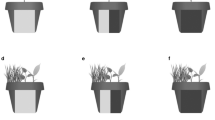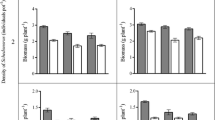Abstract
Background and Aims
In line with the Stress Gradient Hypothesis, studies of facilitation have tended to focus on plant–plant interactions (biotic nurses), while the relative role of abiotic nurses has been little studied. We assessed the role of biotic and abiotic nurses, and their interaction, on soil enhancement and the consequential performance of a native annual grass, Dactyloctenium radulans.
Methods
We used a growth chamber study with two levels of water application to compare the performance of D. radulans growing in soil from foraging pits of the Short-beaked echidna (Tachyglossus aculeatus; abiotic nurse) and non-pit soil from either under tree canopies (biotic nurse) or surrounding open areas.
Results
All measures of plant performance were more pronounced under the high than the low water treatment. The greatest differences between pit and surface Microsites occurred under the low water application, reinforcing our view that facilitatory effects are greater in resource-limited environments. Despite tree canopy soil having greater N, there was no significant effect on plant performance, nor any significant interaction with Microsite.
Conclusions
Our study provides strong evidence that foraging pits enhance soil properties and this soil, in turn, facilitates plant growth; and supports previous work documenting the positive effect of nurse-protégé interactions under greater levels of abiotic stress.


Similar content being viewed by others
Abbreviations
- N:
-
Nitrogen
- C:
-
Carbon
References
Austin AT, Vivanco L (2006) Plant litter decomposition in a semi-arid ecosystem controlled by photodegradation. Nature 442:555–558
Badgery WB, Kemp DR, Michalk DL, King W (2005) Competition for nitrogen between Australian native grasses and the introduced weed Nassella trichotoma. Ann Bot 96:799–809
Belcher JW, Keddy PA, Twolanstrutt L (1995) Root and shoot competition intensity along a soil depth gradient. J Ecol 83:673–682
Bertness MD, Callaway R (1994) Positive interactions in communities. Trends Ecol Evol 9:191–193
BOM (2010) Bureau of Meteorology. Australian Government. http://www.bom.gov.au/
Brooker RW, Callaway RM (2009) Facilitation in the conceptual melting pot. J Ecol 97:1117–1120
Butterfield BJ (2009) Effects of facilitation on community stability and dynamics: synthesis and future directions. J Ecol 97:1192–1201
Byers JE, Cuddington K, Jones CG, Talley TS, Hastings A, Lambrinos JG, Crooks JA, Wilson WG (2006) Using ecosystem engineers to restore ecological systems. Trends Ecol Evol 21:493–500
Caldwell MM, Richards JH (1989) Hydraulic lift—water efflux from upper roots improves effectiveness of water-uptake by deep roots. Oecologia 79:1–5
Callaway RM (1995) Positive interactions among plants. Bot Rev 61:306–349
Callaway RM (2007) Positive Interactions and Interdependence in Plant Communities. Springer, Dordrecht
Castro J, Allen CD, Molina-Morales M, Marañón-Jiménez S, Sánchez-Miranda Á, Zamora R (2010) Salvage logging versus the use of burnt wood as a nurse object to promote post-fire tree seedling establishment. Restor Ecol 19:537–544
Clissold FJ, Sanson GD, Read J (2006) The paradoxical effects of nutrient ratios and supply rates on an outbreaking insect herbivore, the Australian plague locust. J Anim Ecol 75:1000–1013
Cody ML (1993) Do Cholla cacti (Opuntia spp. subgenus cylindropuntia) use or need nurse plants in the Mojave desert? J Arid Environ 24:139–154
Day RL, Laland KN, Odling-Smee J (2003) Rethinking adaptation—the niche-construction perspective. Persp Biol Med 46:80–95
Eldridge DJ, Greene RSB (1994) Assessment of sediment yield by splash erosion on a semiarid soil with varying cryptogam cover. J Arid Environ 26:221–232
Eldridge DJ, Mensinga A (2007) Foraging pits of the short-beaked echidna (Tachyglossus aculeatus) as small-scale patches in a semi-arid Australian box woodland. Soil Biol Biochem 39:1055–1065
Eldridge DJ, Bowker MA, Maestre FT, Alonso P, Mau RL, Papadopoulos J, Escudero A (2010) Interactive effects of three ecosystem engineers on infiltration in a semi-arid mediterranean grassland. Ecosystems 13:499–510
Facelli JM, Brock DJ (2000) Patch dynamics in arid lands: localized effects of Acacia papyrocarpa on soils and vegetation of open woodlands of South Australia. Ecography 23:479–491
Flores J, Jurado E (2003) Are nurse-protege interactions more common among plants from arid environments? J Veg Sci 14:911–916
Gianello C, Bremner JM (1986) Comparison of chemical methods of assessing potentially available organic nitrogen in soil. Comm Soil Sci Plant Anal 17:215–236
Gibson LA (2001) Seasonal changes in the diet, food availability and food preference of the greater bilby (Macrotis lagotis) in south-western Queensland. Wildl Res 28:121–134
Grime JP (1973) Competitive exclusion in herbaceous vegetation. Nature 242:344–347
Hacker SD, Gaines SD (1997) Some implications of direct positive interactions for community species diversity. Ecology 78:1990–2003
Hastings A, Byers JE, Crooks JA, Cuddington K, Jones CG, Lambrinos JG, Talley TS, Wilson WG (2007) Ecosystem engineering in space and time. Ecol Lett 10:153–164
James AI, Eldridge DJ, Hill BM (2009) Foraging animals create fertile patches in an Australian desert shrubland. Ecography 32:723–732
James AI, Eldridge DJ, Moseby KE (2010) Foraging pits, litter and plant germination in an arid shrubland. J Arid Environ 74:516–520
Jeddi K, Cortina J, Chaieb M (2009) Acacia salicina, Pinus halepensis and Eucalyptus occidentalis improve soil surface conditions in arid southern Tunisia. J Arid Environ 73:1005–1013
Keith DA (2004) Ocean shores to desert dunes : the native vegetation of New South Wales and the ACT Dept. of Environment and Conservation (NSW), Hurstville, NSW
Ludwig JA, Tongway DJ (1995) Spatial-organization of landscapes and its function in semiarid woodlands, Australia. Landsc Ecol 10:51–63
Maestre FT, Bautista S, Cortina J (2003) Positive, negative and net effects in grass-shrub interactions in Mediterranean semiarid grasslands. Ecology 84:3186–3197
Maestre FT, Callaway RM, Valladares F, Lortie CJ (2009) Refining the stress-gradient hypothesis for competition and facilitation in plant communities. J Ecol 97:199–205
May FE, Ash JE (1990) An assessment of the allelopathic potential of Eucalyptus. Aust J Bot 38:245–254
Meserve PL, Kelt DA, Milstead WB, Gutierrez JR (2003) Thirteen years of shifting top-down and bottom-up control. Bioscience 53:633–646
Michalet R, Brooker RW, Cavieres LA, Kikvidze Z, Lortie CJ, Pugnaire FI, Valiente-Banuet A, Callaway RM (2006) Do biotic interactions shape both sides of the humped-back model of species richness in plant communities? Ecol Lett 9:767–773
Moorhead DL, Reynolds JF (1993) Changing carbon-chemistry of buried creosote bush litter during decomposition in the Northern Chihuahuan Desert. Am Midl Nat 130:83–89
Munguia-Rosas MA, Sosa VJ (2008) Nurse plants vs. nurse objects: Effects of woody plants and rocky cavities on the recruitment of the Pilosocereus leucocephalus columnar cactus. Ann Bot 101:175–185
Orchard BA, Cullis BR, Coombes NE, Virgona JM, Klein T (2000) Grazing management studies within the temperate pasture sustainability key program: experimental design and statistical analysis. Aust J Exp Agric 40:143–154
Parker KC (1989) Nurse plant relationships of columnar cacti in Arizona. Phys Geogr 10:322–335
Payne RW, Harding SA, Murray DA, Soutar DM, Baird DB, Welham SJ, Kane AF, Gilmour AR, Thompson R, Webster R, Tunnicliffe Wilson G (2007) The Guide to GenStat Release 10, Part 2: Statistics. VSN International, Hemel Hempstead
Peters EM, Martorell C, Ezcurra E (2008) Nurse rocks are more important than nurse plants in determining the distribution and establishment of globose cacti (Mammillaria) in the Tehuacan Valley, Mexico. J Arid Environ 72:593–601
Pugnaire FI, Armas C, Valladares F (2004) Soil as a mediator in plant-plant interactions in a semi-arid community. J Veg Sci 15:85–92
Raffaele E, Veblen TT (1998) Facilitation by nurse shrubs of resprouting behavior in a post-fire shrubland in northern Patagonia, Argentina. J Veg Sci 9:693–698
Riginos C, Grace JB (2008) Savanna tree density, herbivores, and the herbaceous community: bottom-up vs. top-down effects. Ecology 89:2228–2238
Rotundo JL, Aguiar MR (2005) Litter effects on plant regeneration in arid lands: a complex balance between seed retention, seed longevity and soil-seed contact. J Ecol 93:829–838
Sankaran M, Hanan NP, Scholes RJ, Ratnam J, Augustine DJ, Cade BS, Gignoux J, Higgins SI, Le Roux X, Ludwig F, Ardo J, Banyikwa F, Bronn A, Bucini G, Caylor KK, Coughenour MB, Diouf A, Ekaya W, Feral CJ, February EC, Frost PGH, Hiernaux P, Hrabar H, Metzger KL, Prins HHT, Ringrose S, Sea W, Tews J, Worden J, Zambatis N (2005) Determinants of woody cover in African savannas. Nature 438:846–849
Schlesinger WH, Belnap J, Marion G (2009) On carbon sequestration in desert ecosystems. Glob Chang Biol 15:1488–1490
Soliveres S, Eldridge DJ, Maestre FT, Bowker MA, Tighe M Escudero A (2011) Microhabitat amelioration and reduced competition among understorey plants as drivers of facilitation across environmental gradients: towards a unifying framework. Perspec Plant Ecol Evol Syst (in press)
Tilman D (1988) Plant strategies and the dynamics and structure of plant communities. Princeton University Press, USA
van der Putten WH (2009) A multitrophic perspective on functioning and evolution of facilitation in plant communities. J Ecol 97:1131–1138
Verbyla AP, Cullis BR, Kenward MG, Welham SJ (1999) The analysis of designed experiments and longitudinal data by using smoothing splines. J Royal Stat Soc Ser C Appl Stat 48:269–300
Weil RR, Islam KR, Stine MA, Gruver JB, Samson-Liebig SE (2003) Estimating active carbon for soil quality assessment: a simplified method for laboratory and field use. Am J Altern Agric 18:3–17
Whitford WG (2002) Ecology of Desert Ecosystems. Academic Press, London
Acknowledgments
We thank Yvonne Johnson for collecting the Dactyloctenium seed, David Pepper for his insights into nitrogen measurements, Niki Huang for assistance with collecting soil cores, and Geoff McDonald for help with the use of the growth chambers. This research was carried out under Permit No. A2069 from the New South Wales Department of Environment, Climate Change and Water.
Author information
Authors and Affiliations
Corresponding author
Additional information
Responsible Editor: Jeffrey Walck.
Rights and permissions
About this article
Cite this article
Travers, S.K., Eldridge, D.J., Koen, T.B. et al. Animal foraging pit soil enhances the performance of a native grass under stressful conditions. Plant Soil 352, 341–351 (2012). https://doi.org/10.1007/s11104-011-1000-y
Received:
Accepted:
Published:
Issue Date:
DOI: https://doi.org/10.1007/s11104-011-1000-y




